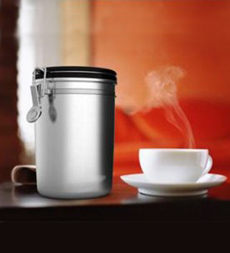TIP OF THE DAY: 6 Steps To Brewing Better Coffee
 It’s easy to brew better coffee. Photo courtesy Filicori Zecchino. |
Do you buy more coffee outside the home because you can’t brew a better cup of coffee? Consider this checklist to improving your home efforts: 1. Start with a clean carafe. Coffee has oil that builds up in the carafe. You can’t see it, but it will become rancid, adding unpleasant flavor notes to the brewed coffee. Similarly, if you live in a hard water area and use tap water to brew, you need to remove the with calcium deposits. While most people rinse out the pot before each use, after every few uses you should wash the glass carafe with white vinegar and water, using a scrubbing brush. Just swishing water around doesn’t do the job. Once a month, run a vinegar-water solution through the entire apparatus, per manufacturer’s instructions. 2. Grind your own beans. It’s less convenient, but coffee beans begin to lose flavor and aroma immediately after grinding. Within two hours, we can taste the difference! It’s better to buy whole beans and grind them immediately prior to brewing. |
|
|
If you don’t have the will to do it, buy small amounts of ground coffee a few times a week, rather than grinding a pound at a time. Experts advise that vacuum packed ground coffee (it’s what Starbucks uses) will turn out a better brew than beans ground at the market for use the next day or beyond. 3. Use the correct grind. Drip machines require a medium grind, espresso machines use a fine grind and French press and drips systems require a coarse grind. If the grind isn’t right for the brewing technique, you won’t get enough extraction from the beans. 4. Don’t use boiling water. Contrary to what most of us have been taught, the temperature of the water should be 200°F, not 212°F. While it doesn’t seem that significant, the extra twelve degrees of heat extract more bitterness and acid from the beans. Good electric coffee makers accommodate for this. If you’re boiling water to pour over ground beans, use a thermometer. You can use any thermometer that measures 200°; Taylor makes a special thermometer for coffee and tea. |
||
|
5. Use the right amount of coffee. The correct measure is two tablespoons of ground beans per six ounces of water. Machines make a six-ounce cup, not an eight-ounce cup. Be sure to use a coffee scoop or the tablespoon from your measuring spoon set, rather than eyeballing the amount with a regular spoon.
6. Don’t store coffee in the freezer or fridge. Beans are porous and easily absorb moisture, odors and flavors. Keep the beans, whole or ground, at room temperature in an airtight container. We use the Friis Coffee Vault, an airtight stainless steel canister specially designed to vent carbon dioxide gas that continuously emits from the beans as a result of the roasting process. |
 Keep whole or ground beans fresh longer in this special airtight container. Photo courtesy Friis. |
|
|
|
||


